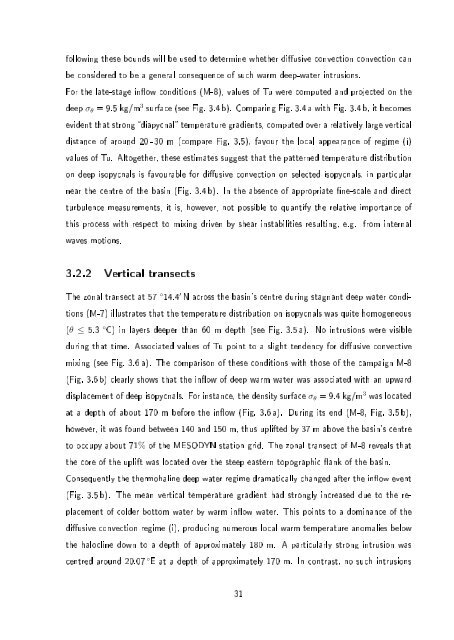Baltic Sea
Baltic Sea
Baltic Sea
You also want an ePaper? Increase the reach of your titles
YUMPU automatically turns print PDFs into web optimized ePapers that Google loves.
following these bounds will be used to determine whether diusive convection convection can<br />
be considered to be a general consequence of such warm deep-water intrusions.<br />
For the late-stage inow conditions (M-8), values of Tu were computed and projected on the<br />
deep σ θ = 9.5 kg/m 3 surface (see Fig. 3.4 b). Comparing Fig. 3.4 a with Fig. 3.4 b, it becomes<br />
evident that strong diapycnal temperature gradients, computed over a relatively large vertical<br />
distance of around 20 - 30 m (compare Fig. 3.5), favour the local appearance of regime (i)<br />
values of Tu. Altogether, these estimates suggest that the patterned temperature distribution<br />
on deep isopycnals is favourable for diusive convection on selected isopycnals, in particular<br />
near the centre of the basin (Fig. 3.4 b). In the absence of appropriate ne-scale and direct<br />
turbulence measurements, it is, however, not possible to quantify the relative importance of<br />
this process with respect to mixing driven by shear instabilities resulting, e.g. from internal<br />
waves motions.<br />
3.2.2 Vertical transects<br />
The zonal transect at 57 ◦ 14.4 ′ N across the basin's centre during stagnant deep water conditions<br />
(M-7) illustrates that the temperature distribution on isopycnals was quite homogeneous<br />
(θ ≤ 5.3 ◦ C) in layers deeper than 60 m depth (see Fig. 3.5 a). No intrusions were visible<br />
during that time. Associated values of Tu point to a slight tendency for diusive convective<br />
mixing (see Fig. 3.6 a). The comparison of these conditions with those of the campaign M-8<br />
(Fig. 3.6 b) clearly shows that the inow of deep warm water was associated with an upward<br />
displacement of deep isopycnals. For instance, the density surface σ θ = 9.4 kg/m 3 was located<br />
at a depth of about 170 m before the inow (Fig. 3.6 a). During its end (M-8, Fig. 3.5 b),<br />
however, it was found between 140 and 150 m, thus uplifted by 37 m above the basin's centre<br />
to occupy about 71% of the MESODYN station grid. The zonal transect of M-8 reveals that<br />
the core of the uplift was located over the steep eastern topographic ank of the basin.<br />
Consequently the thermohaline deep water regime dramatically changed after the inow event<br />
(Fig. 3.5 b). The mean vertical temperature gradient had strongly increased due to the replacement<br />
of colder bottom water by warm inow water. This points to a dominance of the<br />
diusive convection regime (i), producing numerous local warm temperature anomalies below<br />
the halocline down to a depth of approximately 180 m. A particularly strong intrusion was<br />
centred around 20.07 ◦ E at a depth of approximately 170 m. In contrast, no such intrusions<br />
31



